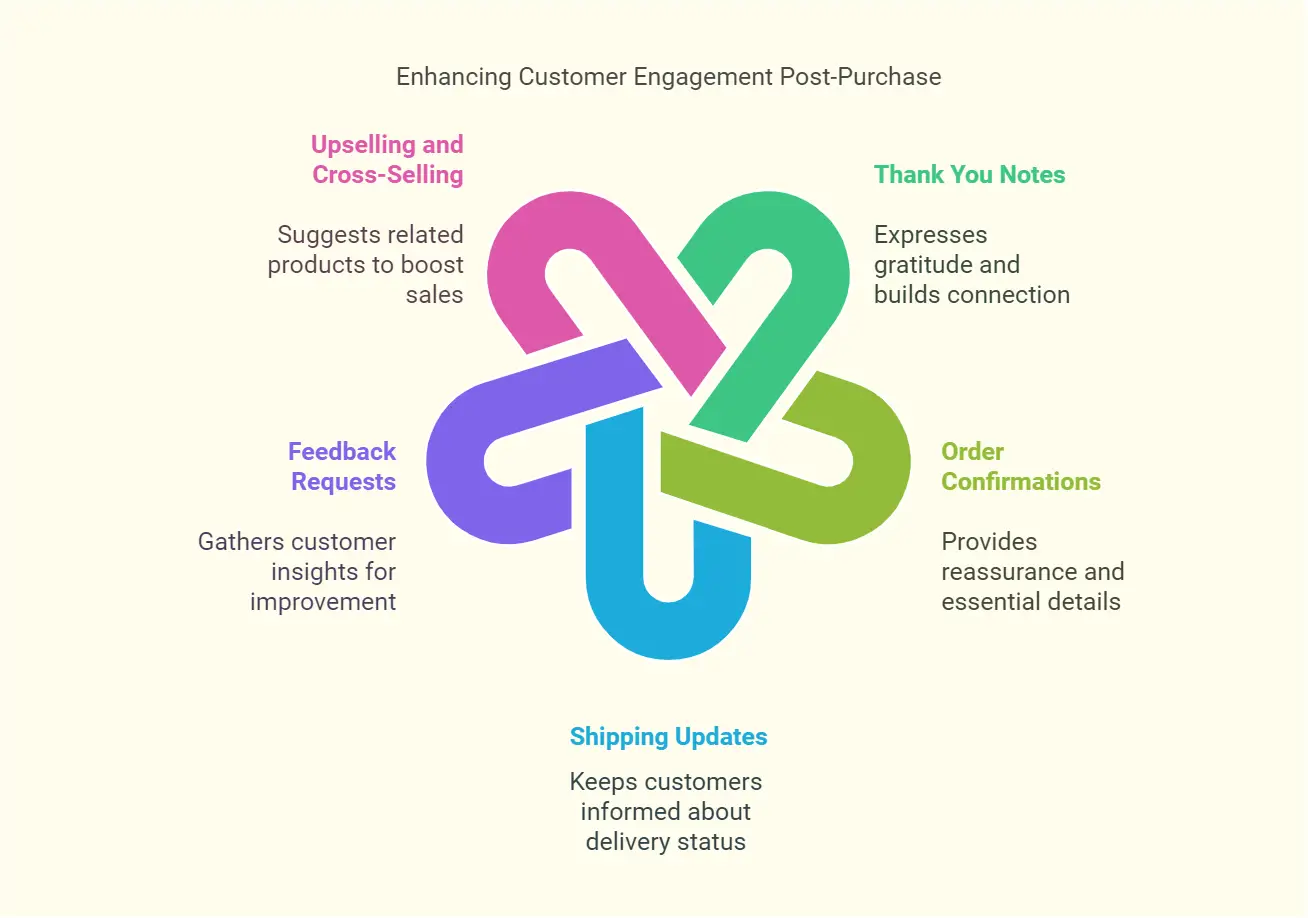How to Engage Customers with Post-Purchase Emails
Understanding how to engage customers with post-purchase emails is essential for brands looking to strengthen their relationship with buyers after a purchase. Post-purchase emails are a powerful tool in the marketing arsenal, allowing businesses to communicate effectively with customers and encourage continued engagement. In this blog post, we will explore various strategies and tips for crafting impactful post-purchase emails that not only enhance customer satisfaction but also drive repeat sales.
Exploring the Value of Post-Purchase Emails

Post-purchase emails serve as a vital touchpoint in the customer journey. They allow businesses to express gratitude, provide essential information, and offer value beyond the initial transaction. In an era where customer experience reigns supreme, understanding the nuances of post-purchase communication can set a brand apart from its competitors.
What Are Post-Purchase Emails?
Post-purchase emails are messages sent to customers after they have completed a transaction. These emails typically cover a range of topics, including order confirmations, shipping notifications, feedback requests, and more.
The primary purpose of these emails is to maintain communication with customers post-purchase, ensuring they feel valued and informed. A well-crafted post-purchase email not only reinforces a positive buying experience but also helps guide customers through the next steps in their journey.
Think of post-purchase emails as an opportunity to build lasting relationships. Instead of simply fading into the background after the sale, brands can use these communications to keep the conversation going, turning one-time buyers into loyal advocates.
How Post-Purchase Emails Boost Customer Engagement
Engagement is the lifeblood of any successful marketing strategy, and post-purchase emails play a crucial role in fostering it. By leveraging these emails effectively, brands can achieve several objectives that contribute to greater customer loyalty and retention.
First and foremost, post-purchase emails create an ongoing connection with customers. When done right, they resonate with recipients, making them feel appreciated and understood. This emotional connection is key to encouraging repeat purchases and cultivating brand loyalty.
Additionally, post-purchase emails can educate customers about product usage, maintenance, or complementary offerings. For instance, a customer who purchased a camera might benefit from receiving tips on how to use it effectively or recommendations for accessories.
By providing valuable content in post-purchase emails, brands can deepen customer engagement and position themselves as trusted resources. This approach not only drives repeat sales but also fosters a community of loyal customers who are likely to advocate for the brand.

Eye-Opening Statistics for Post-Purchase Email Campaigns
Statistics surrounding post-purchase email campaigns underscore their significance in the e-commerce landscape. Research indicates that personalized post-purchase emails can yield higher open and click-through rates compared to generic communications.
Moreover, many consumers report feeling more inclined to make another purchase when they receive engaging emails post-transaction. These insights highlight the importance of tailoring post-purchase communications to meet the specific needs and preferences of customers.
Incorporating statistics into your post-purchase email strategy can enhance your overall marketing efforts. For instance, if you know that a particular segment of your audience responds positively to follow-up offers, you can prioritize those types of communications.
Ultimately, understanding the value of post-purchase emails and their impact on customer engagement lays the groundwork for implementing effective strategies and tactics moving forward.
Tips for Creating High-Impact Post-Purchase Emails

Crafting high-impact post-purchase emails requires attention to detail and a clear understanding of your audience. Here are some key tips to consider when developing your email strategy.
Personalization: Customizing Emails for Unique Experiences
Personalization is no longer optional, it’s expected. Customers appreciate tailored experiences, especially after they make a purchase. By personalizing post-purchase emails, brands can enhance customer engagement and strengthen connections.
Start by addressing customers by their names. This simple gesture can significantly affect the recipient’s perception of the email. Instead of feeling like just another number in a database, customers feel acknowledged and valued.
In addition to using names, consider segmenting your email list based on customer behavior, preferences, or demographics. This allows you to craft relevant content that resonates with specific groups. For instance, a customer who purchased workout gear may appreciate receiving fitness tips or recommendations for complementary products.
Personalization extends beyond just the salutation; it involves creating a holistic experience tailored to individual customers. The more you can customize your post-purchase emails, the more likely you are to foster ongoing engagement.
Personalization plays a key role in building lasting customer relationships. Tools like Mailchimp make it easier to deliver content that resonates with your audience. Mailchimp is a user-friendly platform that empowers you to create highly personalized post-purchase emails. With its drag-and-drop editor, you can customize templates to match your brand’s tone and style. Additionally, Mailchimp provides detailed analytics, enabling you to understand customer responses and refine your strategy.
Email Timing: Key Moments for Success
Timing is essential for post-purchase emails. Sending too early or late can reduce impact. Knowing when to send emails enhances customer engagement.
Right after a purchase, send an order confirmation email to reassure customers about their transaction. Follow up promptly with shipping updates so they can track their package.
After delivery, send emails at strategic times. A week later, a “How’s Your Product?” email can gather valuable feedback. Waiting too long risks losing customer insights.
Consider using post-purchase sequences to gradually introduce new products or services, keeping your brand memorable without overwhelming customers.
Tone and Language: Balancing Friendly and Professional
The tone of post-purchase emails affects customer perception. Finding the right mix of friendly and professional enhances engagement.
A warm tone makes customers feel valued while professionalism builds trust. Use conversational language that reflects your brand personality, like “We’re excited to have you in our community!” instead of formal phrases.
Keep emails brief and easy to read. Avoid lengthy paragraphs; use bullet points to highlight important information, helping customers find what they need quickly.
Overall, the right tone and language strengthen connections with customers and encourage ongoing engagement with your brand.

Effective CTAs: Driving Continued Customer Interaction
A strong call to action (CTA) can make all the difference in your post-purchase emails. An effective CTA guides customers toward the next step you want them to take, whether it’s leaving feedback, exploring new products, or referring friends.
When designing CTAs, keep them clear and concise. Use actionable language that conveys a sense of urgency or importance, phrases like “Share Your Thoughts” or “Explore More Products” can motivate customers to engage further.
Visual appeal also plays a role in CTA effectiveness. Make sure your buttons stand out and are easily clickable, even on mobile devices. Bright colors, contrasting fonts, and ample whitespace can draw attention to your CTAs, increasing the likelihood of interaction.
Lastly, consider A/B testing different CTA options to determine which ones resonate most with your audience. By experimenting with various wording, designs, and placements, you can optimize your post-purchase emails for maximum effectiveness.
Popular Types of Post-Purchase Emails

There are several types of post-purchase emails that businesses can leverage to engage customers effectively. Each type serves a unique purpose and can contribute to a more fulfilling customer experience.
Thank You Notes: Showing Gratitude to Your Customers
A heartfelt thank-you note can go a long way in demonstrating appreciation for your customers. These emails create a positive impression and establish a sense of connection, making customers feel valued and recognized.
In your thank-you notes, acknowledge their purchase specifically and express genuine gratitude. Consider using personalized touches, such as mentioning their name or referencing the item they purchased.
For added impact, consider including a small incentive, such as a discount code for their next purchase. By showing appreciation and offering something in return, you can turn a one-time buyer into a loyal customer.
Order Confirmations: Providing Reassurance and Details
Order confirmation emails are a critical element of post-purchase communication. They provide customers with reassurance that their orders have been successfully placed, alleviating concerns about potential errors.
An effective order confirmation email should include essential details such as the order number, product description, payment receipt, and estimated delivery date. By providing all pertinent information upfront, you empower customers and help them feel informed and secure.
Additionally, consider adding links to customer support or FAQs within the confirmation email. This proactive approach can reduce customer inquiries and provide guests with the tools they need to address any questions or concerns.

Shipping Updates: Keeping Customers in the Loop
Shipping updates are another vital component of post-purchase emails. Informing customers about their shipment status fosters transparency and enhances the overall experience.
Consider sending multiple shipping updates, starting with a notification that their package has shipped, followed by tracking information as it becomes available. This real-time communication ensures customers are aware of when to expect their orders, reducing anxiety and uncertainty.
To further enhance shipping updates, you can personalize them based on customer preferences. For example, if they opted for expedited shipping, highlight that aspect in the email to reinforce the value of their choice.
Feedback Requests: Leveraging Insights for Improvement
Feedback requests are invaluable for businesses seeking to improve their offerings continually. By soliciting input from customers after their purchases, brands gain insights directly from their audience.
When crafting feedback requests, ensure they are straightforward and respectful of customers’ time. Consider using concise surveys or ratings to streamline the process while encouraging participation.
Incentivizing feedback can also increase response rates. Offering a small discount or entry into a giveaway can motivate customers to share their thoughts, providing you with valuable data for future improvements.
Upselling and Cross-Selling Emails: Unlocking Additional Sales Opportunities
Upselling and cross-selling emails can significantly boost revenue while enhancing the customer experience. After a purchase, customers may be interested in related products or upgrades that complement their initial investment.
When crafting these emails, focus on relevance. Highlight items that align with their previous purchases or suggest add-ons that enhance their experience. For instance, if a customer bought a running shoe, you could recommend performance socks or a fitness tracker.
Make sure to present upsell and cross-sell options clearly, emphasizing the benefits of each product. Phrases like “Enhance Your Workout Experience” can capture attention and motivate customers to explore additional offerings.
Evaluating the Performance of Post-Purchase Emails

To ensure the effectiveness of your post-purchase emails, it’s essential to evaluate their performance continuously. Monitoring key metrics allows you to refine your strategy and maximize engagement levels.
Crucial Metrics for Measuring Engagement
Several metrics can provide valuable insights into the performance of your post-purchase emails. Key indicators to monitor include open rates, click-through rates, conversion rates, and unsubscribe rates.
Open rates give you a glimpse into how engaging your subject lines are. High open rates indicate that customers are intrigued enough to open your emails but do not guarantee further engagement. Therefore, it’s essential to analyze click-through rates, which reveal how many customers interact with your content.
Conversion rates indicate the effectiveness of your calls-to-action, after clicking, how many customers took the desired action? Lastly, monitor unsubscribe rates to gauge whether your emails are resonating or causing annoyance.
By analyzing these metrics collectively, you can identify areas for improvement and adapt your strategy accordingly.
Interpreting Customer Feedback and Behavioral Data
In addition to quantitative metrics, qualitative data from customer feedback can provide deeper insights into your post-purchase communication. Regularly reviewing feedback from surveys or follow-up requests can reveal common themes or pain points that warrant attention.
Behavioral data, such as website visits, cart abandonment, and purchase patterns, can also inform your email strategy. By examining how customers interact with your brand before and after transactions, you can tailor your messaging to align with their interests and preferences.
For instance, if customers frequenhttps://gumartech.com/effective-email-marketing-strategiestly abandon carts after receiving certain post-purchase emails, it may signal the need for adjustments. Analyzing behavioral data alongside feedback allows you to create a holistic view of customer engagement.
Experimentation with A/B Testing: Fine-Tuning Email Strategies
A/B testing is a powerful method for optimizing your post-purchase email strategies. By testing variations of subject lines, content, CTAs, and layouts, you can identify what resonates best with your audience.
Start small by changing one element at a time, such as the subject line. For example, test two different subject lines for the same email and compare open rates. Once you identify winning components, apply those insights to future campaigns.
Continually experimenting and refining your post-purchase emails helps you stay attuned to customer preferences. The flexibility to adapt your approach based on data-driven insights ensures that your emails remain relevant and engaging over time.
Proven Strategies for Post-Purchase Email Campaigns

Implementing proven strategies can elevate your post-purchase email campaigns and drive meaningful engagement. Here are some essential strategies worth considering.
Audience Segmentation for Personalized Communication
Audience segmentation allows you to categorize your customers based on shared characteristics, behaviors, or preferences. By segmenting your email lists, you can tailor post-purchase communications to meet the specific needs of each group.
For instance, segment your audience based on factors such as purchase history, geographic location, or demographic information. This enables you to deliver more relevant content and offers that resonate deeply with individual segments.
Personalized communication can lead to higher engagement rates and improved customer satisfaction. When customers receive messages that align with their preferences and interests, they are more likely to respond positively.
Ensuring Brand Consistency in Every Email
Brand consistency is crucial for building trust and recognition among your customers. Ensure that every post-purchase email reflects your brand’s voice, values, and visual identity.
Use consistent branding elements such as logos, colors, and typography across your emails. This cohesiveness reinforces your brand image and fosters familiarity, making your communications more recognizable.
Furthermore, maintain a consistent tone in your messaging. Whether you’re conveying gratitude, providing updates, or requesting feedback, a unified voice enhances the customer experience and solidifies your brand’s identity.
Consistency in tone and design is vital for reinforcing your brand identity. Tools like Mailchimp and Keap provide intuitive design options to ensure all emails align with your brand’s look and feel. Mailchimp offers a library of customizable templates that allow you to maintain consistent visuals across different campaigns. Meanwhile, Keap’s robust features enable businesses to incorporate their brand voice seamlessly into every email. Using these tools ensures that your customers recognize and connect with your brand across every interaction. Learn more at Mailchimp and Keap.

Leveraging Automation for Seamless Campaign Management
Automation is a game-changer for managing post-purchase email campaigns efficiently. Utilizing automation tools allows you to trigger emails based on specific customer actions, ensuring timely communication without manual intervention.
For instance, set up automated workflows to send order confirmation emails immediately after a purchase. Follow up with shipping updates and feedback requests at predetermined intervals. This approach saves time and ensures that no opportunities for engagement are overlooked.
Automation also allows you to scale your post-purchase email efforts seamlessly. As your customer base grows, automated campaigns ensure that each customer receives personalized communication without sacrificing quality.
Adapting Content Based on Customer Preferences
Customer preferences are ever-evolving, making it essential to adapt your post-purchase email content accordingly. Regularly review customer behavior and interests to inform your email strategy.
Utilize data analytics tools to gather insights on what content resonates most with your audience. Pay attention to engagement metrics, click patterns, and feedback to determine which topics or formats receive the best responses.
By staying attuned to customer preferences and adapting your content, you can ensure that your post-purchase emails remain relevant and provide ongoing value.
Wrapping Up
In conclusion, engaging customers with post-purchase emails is a multifaceted endeavor that requires thoughtful strategies and execution. From personalization and timing to effective CTAs and data analysis, every aspect contributes to a comprehensive approach that fosters lasting relationships with customers.
By embracing the power of post-purchase emails, brands can not only enhance the customer experience but also drive repeat sales and build loyalty. As competition in the marketplace continues to grow, investing in meaningful post-purchase communication will undoubtedly set your brand apart.

Remember, the goal of post-purchase emails is not merely to close a transaction but to cultivate a community of engaged customers who see your brand as a trusted partner in their journey. With the right strategies and commitment to continuous improvement, your post-purchase email campaigns can thrive and yield impressive results.




